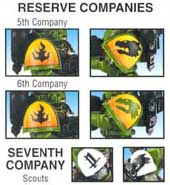 PROMETHEAN
WARRIORS
The Salamanders Space Marine Chapter
As one of the First Founding Chapters, the Salamanders' history goes back to the very birth ot The Imperium. Salamander Space Marines are raised from the populace of Nocturne, a deadly volcanic world. Such a world breeds hardy warriors, strong of constitution and single-minded in purpose; ideal recruits for the Adeptus Astartes. Gav Thorpe takes a closer look at their history from their early beginnings to their involvement on the war-ravaged world of Armageddon. Of all the Emperor's Primarchs, the legend of Vulkan is among the better known tales. The Promethean Opus (source of much Imperial knowledge of Vulkan) tells of a mighty comet blazing a trail of fire across the skies of the world of Nocturne during the Time of Trial, a period of great upheaval when the planet was wracked by massive earthquakes and volcanic eruptions. Whether this was indeed the arrival of the Primarch or merely the herald of his arrival, none can say. The world of Nocturne was a harsh, volcanic place, a land of rocky crags and soaring, basalt mountains with little to offer its early colonists save the riches of its vast mineral deposits. For as long as anyone could remember, Eldar pirates had plagued the people of Nocturne, constantly pillaging the small settlements and enslaving their children. As a result Nocturne's people were hardy and practical, with little time for rest or leisure.
Vulkan's growth was extraordinary. Within three years he was bigger and stronger than any man in the settlement, and his mind was sharper than any Nocturne-forged blade. He had rapidly learned all the skills of metalworking taught to him by N'bel, soon surpassing even his adopted father's renowned ability. It was Vulkan who taught the people of Nocturne the most hidden secrets of metals, the mysteries of pattern welding, metal folding, alloys and bonding, improving their already considerable skill at weapon-making and artifice. The Opus tells that during Vulkan's fourth year, the Eldar came to his town, intent on raiding and pillaging. The people of his settlement had long become used to the Eldar's raids and had devised many ingenious methods of hiding from their attackers. Vulkan declared that he would hide from no-one and, over the pleas of the wise men, stood at the centre of his settlement with his smith's hammers crossed over his shoulders. Stirred by his courage, the men of the settlement rose from their hiding places in attics and cellars to stand beside Vulkan in defiance of their attackers. Vulkan stood at the forefront of the defence and single-handedly slew a hundred Eldar that day, wielding a huge blacksmith's hammer in each hand. The raiders fled from Vulkan's wrath and the story of the town's triumph spread rapidly across Nocturne. Soon the headmen of the seven most important settlements travelled to pay homage to Vulkan, praising him for his example in fighting the Eldar. They swore never again hide in fear, but to face their foes and crush them. It was decided to hold a huge gathering of the people of Nocturne to celebrate this great victory, including a massive contest of skill at arms and craftsmanship. In a passage of the Opus known simply as The Outlander there is the tale of how Vulkan came to be reunited with the Master of Mankind. It recounts that it was at the opening ceremony of the celebrations that a stranger appeared at the gates to Vulkan's settlement. All he asked was to be allowed to take part in the contests and, though he would not say where he had come from, he was allowed to compete. His skin was pale and his garb outlandish, though all could see that he was a powerful figure. He announced to the gathered spectators that he could best any man in any contest. The gathered crowds laughed uproariously, believing that none could be more superior in intellect, physique or skill than their superhuman leader. Vulkan and the stranger wagered that whoever lost was to swear eternal obedience to the victor. The competitions lasted for eight days and included many feats of strength and endurance. At the anvil lift, even the strongest men could only hold an anvil above their head for an hour and a half, but Vulkan and the stranger carried the heavy anvil aloft for half a day before the judges declared the contest a draw so that they could proceed to the next event. And so it was that they were almost equally matched in skill and strength. Occasionally one would slightly best the other, but when it came to the start of the final event, the salamander slaying, they were evenly matched. Each had a day and a night to forge a weapon with which to hunt down the largest salamander they could find. Whoever could bring back the heaviest carcass would win the wager and the eternal allegiance of the other. The ringing of hammers on metal echoed across the volcanic hills for the whole day, neither man pausing for a moment to rest or refresh himself. As the Nocturne sun sank below the mountains, they watched the highest peaks for the fire plumes that gave sign of the giant salamanders. Vulkan boasted that he would climb to the summit of Mount Deathfire, where the largest firedrakes could be found, huge fire-breathing monsters weighing several tons. The stranger nodded in agreement and said that wherever Vulkan went, he would follow.
Just as Vulkan's grip was beginning to slip, the stranger appeared, calling his name from the other side of a wide lava flow. Vulkan answered the cry and could see that the stranger's prey was indeed larger than his own. By now even Vulkan's almost endless constitution was growing slim, weakened as he was by over a week of hard contest. His grip was shaking, and yet he was too proud to call for help. But it seemed that the stranger realised the Primarch's peril, and hurled the corpse of his salamander into the lava, making himself a bridge to cross. With great leaps the stranger hurled himself towards Vulkan, hauling the wearied Primarch from the edge of the abyss. Even as Vulkan felt himself being pulled up by the stranger's strong arms, he saw the salamander's body being consumed by the lava and swept away. When the two returned to the Primarch's settlement, it was the ruling of the judges that Vulkan had won, for the stranger had returned with no prize at all. The gathered throng cheered heartily, but were silenced by Vulkan. As they watched, he knelt on one knee and bowed his head to the stranger, saying that any man who valued life over pride was worthy of his service. The stranger bade Vulkan stand and threw off the illusion that had disguised his true form, revealing himself to be the Holy Emperor of Mankind. The people of Nocturne fell to their knees in awe and, from that day forth, their world was to become home to the Salamanders Legion, in memory of the mighty beasts that had united the Primarch and his Lord. The Salamanders Chapter hails from a binary planetary system in the western reaches of the Ultima Segmentum. The two worlds, Nocturne and its oversized moon Prometheus, circle each other in an erratic orbit, causing massive tectonic activity across the thin crust of Nocturne. The world is girded by chains of active volcanoes and rent apart by frequent earthquakes. Once every Nocturne year, some fifteen Terran years long, the two worlds approach so closely that Nocturne is almost torn asunder. Known as the Time of Trial, this period is marked by tidal waves sweeping across the rough seas, the ash and smoke from thousands of volcanoes blotting out the dim fight of Nocturne's sun, and the ground gripped by constant earthquakes. Towns and villages are thrown into ruin, continents shift and a cold winter envelops the lands for the next quarter of a year, freezing the young and killing the majority of the livestock that can survive the normally harsh and hot climate of the planet. Some would say that the people of Nocturne are mad to endure such conditions, but over hundreds of generations they have been moulded by their world into a hardy race. And Nocturne's Time of Trials brings great rewards too. The upheavals open up veins of precious gems and metals, uncovering vital ores for smelting. When the lava flows cool, they can be mined for other precious elements, pockets of gas that can be used to power engines, diamonds and other crystals valuable to the Adeptus Mechanicus for lasers and energy transmission systems. And this is how Nocturne survives, by trading its vast mineral wealth with other worlds, using its resources to bring in additional livestock, building materials and the few weapons that the Salamanders Space Marines cannot construct themselves. The Chapter's fortress-monastery is based upon the giant moon, Prometheus. It is the only settlement on Prometheus and is little more than a spaceport linked to an orbital dock where the Chapter's strike cruisers and battle barges can be refitted and restocked. When not at war, the Chapter's warriors spend most of their time on Prometheus or living amongst the inhabitants of Nocturne. The Salamanders maintain very close links with their home world, mingling with the people rather than living aloof as many other Chapters do. The Salamanders are the settlements' leaders, a source of inspiration and guidance for the Nocturne populace, and it is as much this position of authority and respect that young aspirants crave as the chance to become a legendary warrior of the Emperor.
The Salamanders follow normal Space Marine tactical and strategic dogma, with a slight variation to compensate for their own physical and mental traits. They have a preference for close-ranged firefights, using many melta and flamer weapons to smash armoured foes and bum whole swathes of lighter troops. Coming from a society that places great prestige in craftsmanship and which has high regard for artisans, the Salamanders have access to, and can maintain, highly sophisticated forms of technology. This is most evident in the numbers of Terminators in their armies, as well as a greater proportion of artificer armour and master-crafted weaponry and is supplemented by regular trade with the Adeptus Mechanicus, made possible by Nocturne's abundant mineral resources. The Salamanders Chapter organisation was laid down when Vulkan swore allegiance to the Emperor. Each Company was founded from the seven greatest settlements of Nocturne, each commanded by a Captain from that settlement. This organisation is still true today, although ever since the disappearance of Vulkan some thousand years after the Legion's Founding, the Captain of the First Company has been given the role of Chapter Master. This position is considered a regency by the Salamanders, who believe that one day Vulkan will return to lead the Chapter in a great campaign to conquer Chaos. Each Company is slightly larger than a standard Codex Company, and squads were reorganised following Roboute Guilliman's writing of the Codex Astartes after the Great Heresy. The conditions on Nocturne are not conducive to training for high speed attack or using the anti-grav engines of Land Speeders, so the Chapter employs relatively few of these specialised fast attack units. The Apocrypha of Skaros lists the Salamander's Scout Company as one of the smallest known in any Chapter; the sparse population of Nocturne and the Salamanders' slow but meticulous selection process giving a low turnaround of new recruits. The First Company is treated as a warrior cadre within the Headquarters itself, and forms the personal guard of the Chapter Master. They are known as the Firedrakes, after the largest of the salamander lizards that roam Nocturne. To enter the First Company, a warrior must be nominated by his Captain for the honour, and then must prove that such faith was well founded by slaying a firedrake. The Hall of the Firedrakes in the Chapter Monastery on Prometheus is hung with the hides from Firedrake salamanders slain as part of this trial. The beliefs of the Salamanders are governed by the Promethean cult, which places great emphasis on self-reliance, loyalty and self-sacrifice. Much of this stems from the lessons learnt while training as a smith -patience with relentless determination are highly valued mental characteristics. The hammer and fire are important symbols in the teaching of the Promethean cult. Ritual scarring by branding and burning is commonplace amongst the battle brothers of the Salamanders, and trials of walking over burning coals and carrying red-hot metal bars are held frequently. As far as can be ascertained, the Salamanders' gene-seed appears to be stable and as yet uncorrupted. The reflexes of Salamanders Space Marines are not as fast as those of other Chapters, although still quick when suited in power armour. However, it is unknown whether this is due to a defect in the gene-seed, a result of their high gravity world, or comes about from the Chapter's doctrines against hastiness and impetuosity. The Salamanders have never been great in number and were the smallest of the First Founding Legions. Perhaps it is for this reason that there seem to have been no Second Founding successor Chapters formed from the Salamanders, whilst the other Legions were broken down into several smaller fighting forces. Others point to the disaster at Istvaan V as reason for the lack of Second Founding Chapters (as many scholars believe the Salamanders to have been present at this infamous massacre). It is a matter of debate whether there have been Successor Chapters during subsequent Foundings, although it appears likely and many scholars point to similarities in the physique, markings and tactical dogma of Chapters such as the Storm Giants and Black Dragons. Recent questions regarding the purity of the Black Dragons' gene-seed has led to some Genetor-Biologis questioning the purity of their source zygotes, but the legacy and reputation of the Salamander has led to their detractors being openly ridiculed. "Into the fires of battle, unto the anvil of war!"
When Ghazghkull launched his new offensive against the Imperial forces on Armageddon, the Salamanders were one of the first Chapters to respond, sending a full six Companies to combat the Orks, including Chapter Master Tu'Shan personally leading his Firedrakes. The Salamanders have launched several counter-attacks against the rock-forts landed by the Orks along the Hemlock river. Preferring the close-quarter lighting within the maze of crudely carved tunnels within the Roks to the long-range duels in the desert, the Salamanders have made the Orks pay a high price for their audacity. At least three Roks have been destroyed by the Salamanders' attacks, killing untold thousands of greenskins. THE SALAMANDERS'
CHAPTER
ORGANIZATION HEADQUARTERS
BATTLE COMPANIES
RESERVE COMPANIES
|
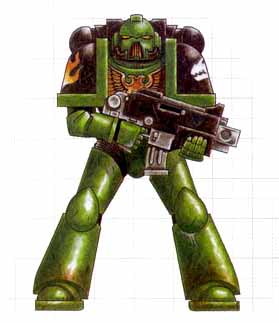 It
is said in the Promethean Opus that the Primarch was found one morning
by a blacksmith named N'bel as he entered the yard of his smithy. Whether
as a babe in swaddling clothes or as an infant child is unclear, but
the unknown child's presence in a smithy's yard was unusual enough for
N'bel to bring him before the ruling council of his settlement. For
many of the long, Nocturne years, the wise men had prophesied the arrival
of a saviour, a warrior who would come to them from the heavens to rid
them of the decadent Eldar. So it was that the people instantly recognised
the greatness within the infant that N'bel had found. No one dared claim
the Primarch as their own and thus it was decreed that N'bel take the
Primarch in as his son and apprentice. The master smith named him Vulkan,
after the first king of the salamanders, the giant lizards that roam
the volcanic mountains of Nocturne.
It
is said in the Promethean Opus that the Primarch was found one morning
by a blacksmith named N'bel as he entered the yard of his smithy. Whether
as a babe in swaddling clothes or as an infant child is unclear, but
the unknown child's presence in a smithy's yard was unusual enough for
N'bel to bring him before the ruling council of his settlement. For
many of the long, Nocturne years, the wise men had prophesied the arrival
of a saviour, a warrior who would come to them from the heavens to rid
them of the decadent Eldar. So it was that the people instantly recognised
the greatness within the infant that N'bel had found. No one dared claim
the Primarch as their own and thus it was decreed that N'bel take the
Primarch in as his son and apprentice. The master smith named him Vulkan,
after the first king of the salamanders, the giant lizards that roam
the volcanic mountains of Nocturne.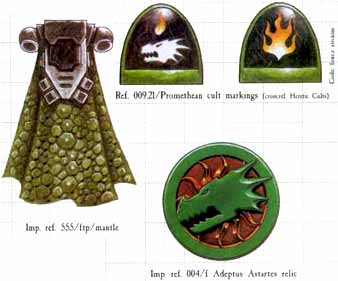 It
is claimed that the two climbed the precipitous mountains with astounding
speed, bounding from rock to rock, the stranger carrying a keen-edged
blade, Vulkan with his immense silver-headed hammer held ready. They
passed from sight, but soon the skies echoed to the clamour of battle,
and the flames of the firedrakes licked the clouds of smoke that gathered
over the volcanoes. Vulkan was to find his prey first, smashing its
armoured head from its shoulders with a mighty sweep of his hammer.
Further up the mountain, the stranger spied another, even mightier salamander
than Vulkan's conquest and set off in pursuit. As Vulkan carried his
prize back to the settlement, ill fate beset him as Mount Deathfire
erupted into violent life, hurling rocks and lava high into the air.
He was flung from the edge of a precipice, where he clung for several
hours by one hand, the other grimly holding the tail of the dead salamander.
Vulkan was determined to keep his prize, no matter the cost. As the
mountain continued to erupt, Vulkan knew he could not hold on much longer,
yet still he refused to release his grip on the salamander.
It
is claimed that the two climbed the precipitous mountains with astounding
speed, bounding from rock to rock, the stranger carrying a keen-edged
blade, Vulkan with his immense silver-headed hammer held ready. They
passed from sight, but soon the skies echoed to the clamour of battle,
and the flames of the firedrakes licked the clouds of smoke that gathered
over the volcanoes. Vulkan was to find his prey first, smashing its
armoured head from its shoulders with a mighty sweep of his hammer.
Further up the mountain, the stranger spied another, even mightier salamander
than Vulkan's conquest and set off in pursuit. As Vulkan carried his
prize back to the settlement, ill fate beset him as Mount Deathfire
erupted into violent life, hurling rocks and lava high into the air.
He was flung from the edge of a precipice, where he clung for several
hours by one hand, the other grimly holding the tail of the dead salamander.
Vulkan was determined to keep his prize, no matter the cost. As the
mountain continued to erupt, Vulkan knew he could not hold on much longer,
yet still he refused to release his grip on the salamander.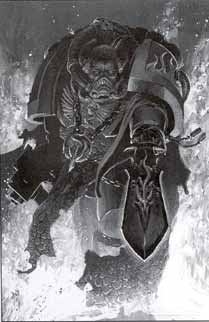 Recruitment
starts very young for the Salamanders, with a hopeful coming to work
as an apprentice to a Salamander at the age of six or seven Terran years.
They will then spend several more years learning the skills of the smith,
as Vulkan did in his early life. From these apprentices, the most able
will then be judged by the Chapter's Apothecaries and Chaplains and
the worthy wilt be taken to Prometheus to undergo the bio-surgery required
to make them into Space Marines. At various points in their adaptation
and training, the young Scouts must endure the same trials and tests
that Vulkan and the Emperor competed in, their final initiation culminating
in them hunting down a salamander and slaying it.
Recruitment
starts very young for the Salamanders, with a hopeful coming to work
as an apprentice to a Salamander at the age of six or seven Terran years.
They will then spend several more years learning the skills of the smith,
as Vulkan did in his early life. From these apprentices, the most able
will then be judged by the Chapter's Apothecaries and Chaplains and
the worthy wilt be taken to Prometheus to undergo the bio-surgery required
to make them into Space Marines. At various points in their adaptation
and training, the young Scouts must endure the same trials and tests
that Vulkan and the Emperor competed in, their final initiation culminating
in them hunting down a salamander and slaying it.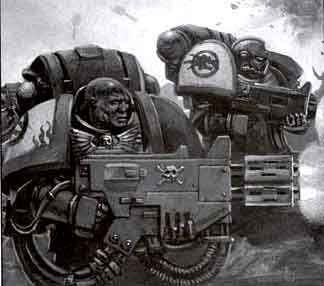 The
Salamanders have been involved in many magnificent conquests and wars,
but in recent times even these great achievements have been eclipsed
by their stalwart fighting during the Second Armageddon War While rhe
Blood Angels set about destroying the Ork horde, and the Ultramarines
bent their strength to the defence of the surviving hive cities, the
Salamanders took upon themselves the essential but neglected task of
protecting the supply convoys, fighting rearguard actions against the
Ork advances and escorting refugee columns. So unstinting were they
in these arduous but unsung duties, the Salamanders were to earn the
gratitude and respect of thousands of Imperial Guardsmen and civilians.
The Salamanders have become renowned as sturdy and dependable allies,
a reputation which is not shared by other more unpredictable, Chaplers
The
Salamanders have been involved in many magnificent conquests and wars,
but in recent times even these great achievements have been eclipsed
by their stalwart fighting during the Second Armageddon War While rhe
Blood Angels set about destroying the Ork horde, and the Ultramarines
bent their strength to the defence of the surviving hive cities, the
Salamanders took upon themselves the essential but neglected task of
protecting the supply convoys, fighting rearguard actions against the
Ork advances and escorting refugee columns. So unstinting were they
in these arduous but unsung duties, the Salamanders were to earn the
gratitude and respect of thousands of Imperial Guardsmen and civilians.
The Salamanders have become renowned as sturdy and dependable allies,
a reputation which is not shared by other more unpredictable, Chaplers


